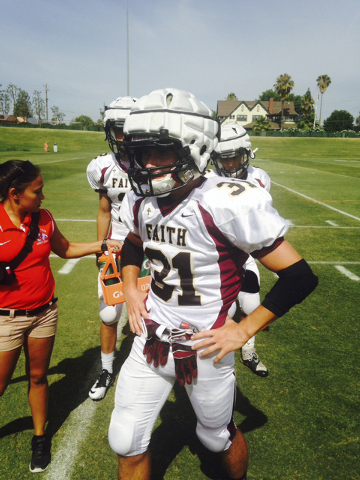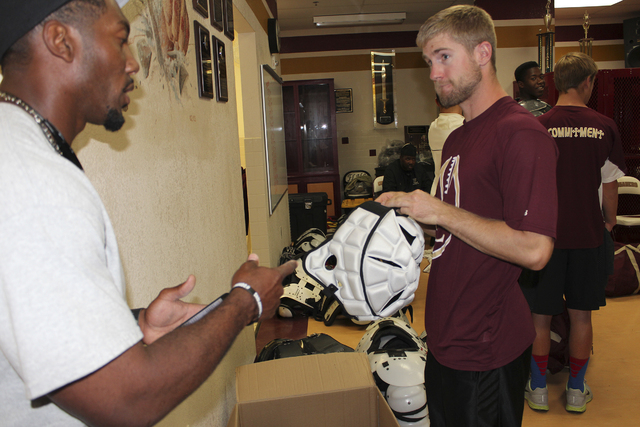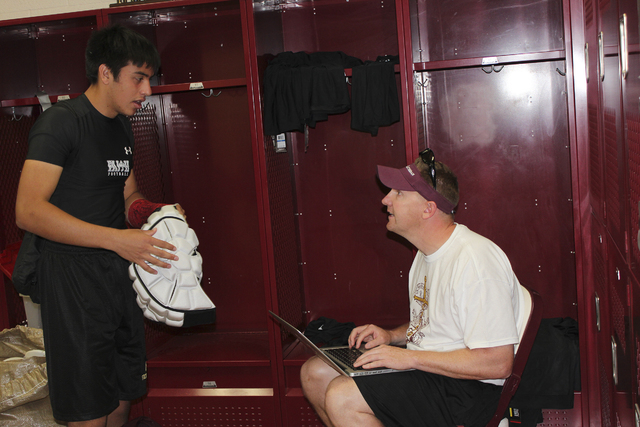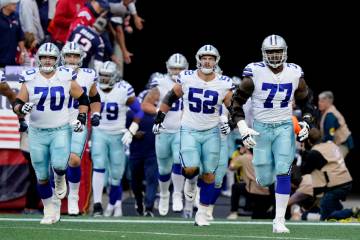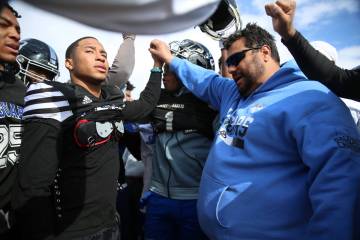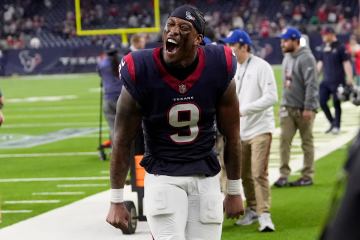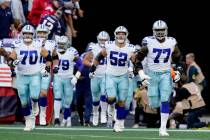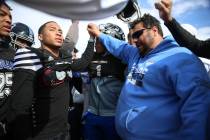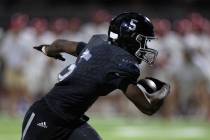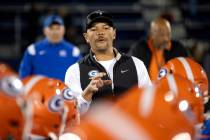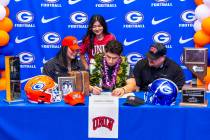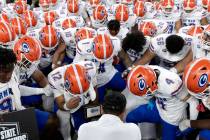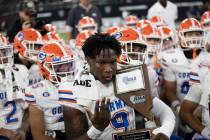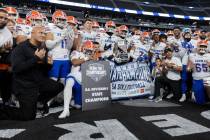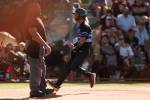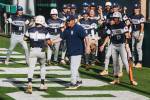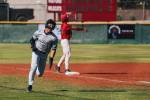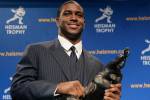Faith Lutheran hopes helmet covers cut down on concussions
Vernon Fox knows firsthand about head trauma. He suffered from it after playing football at the highest levels.
Fox, in his second year as the coach at Faith Lutheran High School, was a two-time all-conference safety at Fresno State, then played eight years in the NFL. He had three concussions during those years — that he knows of.
“I don’t know how many I shook off as ‘a dinger’ and kept going,” said Fox, a 1997 Cimarron-Memorial graduate. “I struggled badly with blurred vision the last two years of college from post-concussion syndrome, and after I retired, I was medicated for chronic migraines associated with my playing career.
“So there is a reason it’s so important to me to protect my players.”
His players are the defending Division I-A state champions who began noncontact practice Thursday, and Fox is trying to protect them by using a new product designed to help reduce the impact players feel upon contact with one another.
Guardian Caps is a one-size-fits-all helmet cover that can be worn over any current helmet. The Crusaders will wear them during practices this season.
More than 20,000 Guardian Caps are being worn by high schools and colleges across North America, but Faith Lutheran was the first in Nevada to use them. The Crusaders wore them at a summer football camp at Fresno State, and Fox said no players complained of concussion-like symptoms afterward.
Fox became sold on the product when he heard that a former NFL teammate — one who was involved in perhaps the hardest collision Fox ever saw — was using them with the youth teams he coaches in Georgia.
Fred McCrary played fullback in the NFL for 11 seasons. He says he sustained “hundreds” of concussions during his career, and today suffers regularly from migraines.
One of those concussions was the result of a collision with the late Junior Seau when McCrary and Fox played for the San Diego Chargers.
Lined up in the offensive backfield, the 6-foot, 250-pound McCrary met Seau, a 6-3, 250-pound linebacker, at the line of scrimmage during a practice drill.
Seau won.
By how much? The impact was so forceful it left a 4- to 5-inch crack across the bridge of McCrary’s helmet.
“It sounded like a 12-gauge shotgun,” McCrary said. “The coaches used to tell us — Junior and I — to set the tone; that’s what fullbacks and linebackers do. Well, we set the tone. I had a concussion for two or three days after that. That was my worst year. Every time I got hit or hit somebody, I would just see white. It was terrible. I was like, ‘What the hell is wrong with me,’ but now I know what was wrong.
“I don’t even remember that year.”
McCrary said he initially came across Guardian Caps online. Since his teams started using them, no players have reported concussion-like symptoms.
“That’s a green light right there,” said McCrary, who was one of more than 4,500 former players involved in the highly publicized class-action lawsuit against the NFL. “This thing needs to take over. I care about the kids and protecting them.
“Honestly, I wish they had a way to put the logos on the side of the Guardian Cap so we could use them in games. I’m adamant about it, all (youth football) teams need to implement this immediately. We need to protect these babies starting football.”
Fox talked with Faith Lutheran athletic director Bret Walters about Guardian Caps, and they decided it was worth the investment.
“We felt it was our duty to check this out for the best interest of the kids,” Walter said. “Sure, we’ve heard differing opinions, but we wanted to try it out ourselves and get feedback from our kids. This was the first time we have had no concussions or headaches after a camp, so our first experience with the Guardian Cap has been a positive.”
Senior defensive back Tyler Mahan echoed those thoughts.
“The impact from a helmet-to-helmet collision isn’t nearly as painful, nor does it last as long,” he said.
About 11 percent of athletic and activities injuries reported to the Clark County School District are concussion-related, according to Jim Porter, the Area Sports Medicine Coordinator for Select Physical Therapy Athletic Training Services.
Since 2004, the average per school year is about 380 concussion-related injuries in all sports. And of those, about 63 percent are football-related.
“The definition of a concussion and how it is managed changed dramatically in the mid-2000s,” Porter said. “The biggest misconception is that they’re not a serious injury. We have parents who will look us in the eye and say, ‘It’s just a concussion, it’s no big deal.’ But it is a very big deal.”
Porter says times have changed from when parents were playing sports and concussions weren’t considered serious injuries. Now, he said, research has revealed someone over the age of 21 needs seven to 10 days of rest before being evaluated to return to action. High school athletes need 21 days, and youths under 16 can take up to six months to recover because their brain is still developing.
“There are no outward symptoms,” Porter said. “If you break your arm, you look at it and say ‘it’s broken.’ Concussions are subtle … it doesn’t look like a serious injury. (Parents) want to know how soon (their kids) can play again. There is no set time when he or she can return. We don’t know, and there’s no way (to determine).”
Porter has specific concerns regarding the Caps, but said if those issues can be addressed effectively, he’s all for anything that will increase safety on the field. His initial questions were: How many hits can Guardian Caps take, are they weather-worn, and how is the structure of the helmets checked after practices.
“It’s designed to absorb force; we know that,” Porter said. “But the helmets we’re using today are designed to deflect impact. The shape of the helmets have changed since 1999. Certain manufacturers have built face masks to absorb shock. The problem I have is when I put the Cap on the helmet, it changes the design of the helmet. It’s already designed to deflect the force and reduce impact.”
The Clemson Tigers implemented Guardian Caps into their practices last season, and while head trainer Danny Poole said he’s unsure how much they’ve prevented any sort of potential head injury, they’ve been well received.
“I knew that these were not going to stop concussions, but what I was more intrigued about was the guys down in the trenches — the linemen — where they’re in constant contact with one another during practice,” Poole said. “The linemen tell me there is a little bit more of a softening of the blow. There is still head contact daily in practice, but this just softens the blow.
“In today’s climate, we’re all trying to do everything we can do for player safety. If this is one thing that maybe over time will help a kid avoid repetitive head trauma, we’ve done a good job.”
Fox agrees and also is realistic.
“There is no product that is going to eliminate the chance of a concussion,” he said. “As a former player, I know — head contact is inevitable.
“We’re still going to teach proper technique, and we want our young men to tackle properly. We’re hoping that this is just another alternative as an aid to further protect them.”




